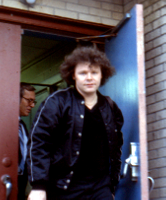
A big band or jazz orchestra is a type of musical ensemble of jazz music that usually consists of ten or more musicians with four sections: saxophones, trumpets, trombones, and a rhythm section. Big bands originated during the early 1910s and dominated jazz in the early 1940s when swing was most popular. The term "big band" is also used to describe a genre of music, although this was not the only style of music played by big bands.
Swing music is a style of jazz that developed in the United States during the late 1920s and early 1930s. It became nationally popular from the mid-1930s. Swing bands usually featured soloists who would improvise on the melody over the arrangement. The danceable swing style of big bands and bandleaders such as Benny Goodman was the dominant form of American popular music from 1935 to 1946, known as the swing era, when people were dancing the Lindy Hop. The verb "to swing" is also used as a term of praise for playing that has a strong groove or drive. Musicians of the swing era include Duke Ellington, Benny Goodman, Count Basie, Cab Calloway, Benny Carter, Jimmy Dorsey, Tommy Dorsey, Woody Herman, Earl Hines, Bunny Berigan, Harry James, Lionel Hampton, Glenn Miller, Artie Shaw, Jimmie Lunceford, and Django Reinhardt.

Walter Maynard Ferguson CM was a Canadian jazz trumpeter and bandleader. He came to prominence in Stan Kenton's orchestra before forming his own big band in 1957. He was noted for his bands, which often served as stepping stones for up-and-coming talent, his versatility on several instruments, and his ability to play in a high register.
The swing era was the period (1933–1947) when big band swing music was the most popular music in the United States, especially for teenagers. Though this was its most popular period, the music had actually been around since the late 1920s and early 1930s, being played by black bands led by such artists as Duke Ellington, Jimmie Lunceford, Bennie Moten, Cab Calloway, Earl Hines, and Fletcher Henderson, and white bands from the 1920s led by the likes of Jean Goldkette, Russ Morgan and Isham Jones. An early milestone in the era was from "the King of Swing" Benny Goodman's performance at the Palomar Ballroom in Los Angeles on August 21, 1935, bringing the music to the rest of the country. The 1930s also became the era of other great soloists: the tenor saxophonists Coleman Hawkins, Ben Webster and Lester Young; the alto saxophonists Benny Carter and Johnny Hodges; the drummers Chick Webb, Gene Krupa, Jo Jones and Sid Catlett; the pianists Fats Waller and Teddy Wilson; the trumpeters Louis Armstrong, Roy Eldridge, Bunny Berigan, and Rex Stewart.
Franklin "Lin" Biviano is an American jazz trumpeter best known for his powerful lead trumpet playing with Buddy Rich, Count Basie, and Maynard Ferguson. He has also played and recorded with Hoagy Carmichael, Jo Ann Castle, Bill Chase, Buddy DeFranco, Jimmy Dorsey, Ella Fitzgerald, Woody Herman, Milt Jackson, Harry James, Stan Kenton, Glenn Miller, Frank Sinatra, Steve Smith, Mel Tormé, Sarah Vaughan, Fats Waller, and Lawrence Welk, mostly playing lead trumpet. From 1974-1976 he led his own big band; they toured the East Coast and recorded the single L.A. Expression with Love Is Stronger Far Than We on the flipside. From 1964-1965, he attended Berklee School of Music, and in 2002 he was asked to return as a teacher; as of 2017 he is still on the faculty, teaching mainly ensembles and private lessons.
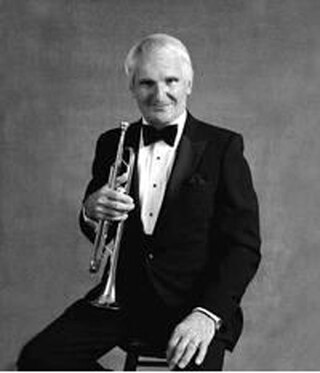
Secondo "Conte" Candoli was an American jazz trumpeter based on the West Coast. He played in the big bands of Woody Herman, Stan Kenton, Benny Goodman, and Dizzy Gillespie, and in Doc Severinsen's NBC Orchestra on The Tonight Show Starring Johnny Carson. He played with Gerry Mulligan, and on Frank Sinatra's TV specials. He also recorded with Supersax, a Charlie Parker tribute band that consisted of a saxophone quintet, the rhythm section, and either a trumpet or trombone.

Marion "Buddy" Childers was an American jazz trumpeter, composer and ensemble leader. Childers became famous in 1942 at the age of 16, when Stan Kenton hired him to be the lead trumpet in his band.

The Count Basie Orchestra is a 16- to 18-piece big band, one of the most prominent jazz performing groups of the swing era, founded by Count Basie in 1935 and recording regularly from 1936. Despite a brief disbandment at the beginning of the 1950s, the band survived long past the big band era itself and the death of Basie in 1984. It continues under the direction of trumpeter Scotty Barnhart.
William Joseph Russo was an American composer, arranger, and musician from Chicago, Illinois, United States.
Wayne Bergeron is an American jazz trumpeter.

Lewis Michael Soloff was an American jazz trumpeter, composer, and actor.

Georgie Auld was a jazz tenor saxophonist, clarinetist, and bandleader.
Carl Saunders was an American jazz trumpeter, composer, and educator who performed with such luminaries as Stan Kenton, Buddy Rich, Bill Holman, Clare Fischer, Frank Sinatra, Ella Fitzgerald, Mel Tormé, and Paul Anka.
Alvin Stoller was an American jazz drummer. Though he seems to have been largely forgotten, he was held in high regard in the 1940s and 1950s. He was best known for playing drums on both Mitch Miller's recording of "The Yellow Rose of Texas" and Stan Freberg's parody of Miller's recording.

Willis Leonard Holman was an American composer, arranger, conductor, saxophonist, and songwriter working in jazz and traditional pop. His career spanned over seven decades, starting with the Charlie Barnet orchestra in 1950.

Herbert Arnold Geller was an American jazz saxophonist, composer and arranger. He was born in Los Angeles.
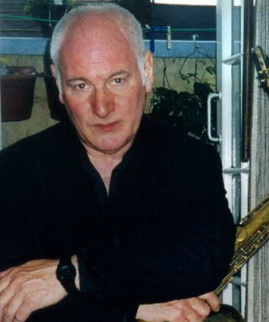
Stan Robinson was an English jazz tenor saxophonist and flautist.
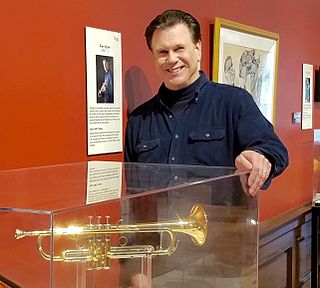
Roger O'Neal Ingram is a jazz trumpeter, educator, author, and instrument designer. He played trumpet for the orchestras of Maynard Ferguson, Woody Herman, Wynton Marsalis, Ray Charles, and Harry Connick Jr.

Ernie Hammes is a Luxembourger trumpet virtuoso, arranger, composer, and big band director who is prolific in both jazz and classical idioms. Notably in jazz, Hammes toured with Maynard Ferguson's Big Bop Nouveau band in 2005, alternating between the lead and jazz roles. Hammes has performed in more than twenty-five countries while simultaneously supporting the jazz scene in Luxembourg.
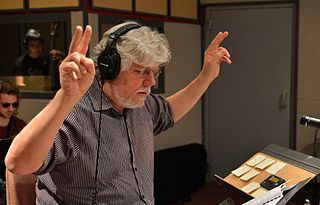
Steve Wiest(néJohn Stephen Wiest; born 1957) is an American trombonist, composer, arranger, big band director, music educator at the collegiate level, jazz clinician, author, and illustrator/cartoonist. From 1981 to 1985, he was a featured trombonist and arranger with the Maynard Ferguson Band. Wiest is in his eleventh year as Associate Professor of Jazz Studies and Commercial Music at the University of Denver Lamont School of Music. He is the Coordinator of the 21st Century Music Initiative at the school. Wiest has been a professor for thirty-six of the forty-four years that he has been a professional trombonist, composer, and arranger. From 2007 to 2014, Wiest was Associate Professor of Music in Jazz Studies at the University of North Texas College of Music and, from March 2009 to August 2014, he was director of the One O'Clock Lab Band and coordinator of the Lab Band program. At North Texas, Wiest also taught conducting, trombone, and oversaw The U-Tubes — the College of Music's jazz trombone band. Wiest is a three-time Grammy nominee — individually in 2008 for Best instrumental Arrangement and in 2010 for Best Instrumental Composition, and collaboratively in 2010 for Best Large Jazz Ensemble Album, which he directed. As of 2013, Wiest has in excess of 58 arrangements and compositions to his credit, which include 10 original compositions from his current project (see 2013–2014 project below).
